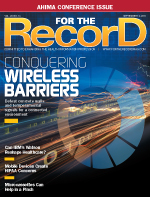 September 12, 2011
September 12, 2011
Old Reliables Still Producing
By Denise M. O’Neal
For The Record
Vol. 23 No. 16 P. 7
I remember the first time I transcribed a medical report. It was from a big, bulky tape recorder that held a 5- X 7-inch compact cassette tape. Things got a bit fancier when the Olympus microcassette transcriber was introduced in 1979. This machine held a 2- X 11/2-inch microcassette with 30 minutes of recording on each side. Shortly thereafter, a 90-minute microcassette that held 45 minutes of recording on each side hit the market.
Then, just when you thought it was safe to stock up on microcassettes, the mother of all dictation systems made its debut in the early 1980s. The Lanier digital transcription machine worked via a phone line; no cassette tapes were necessary. The dictation came through on a PD format default (a type of wave file). All you had to do was dial in to the machine and start transcribing.
Lanier was the most popular of this kind of technology. Costing about $2,500 per machine, the technology saw use in just about every hospital in those days. And if you were a work-from-home transcriptionist, more than likely you were also using a Lanier. Having experience with a Lanier could land you a job just about anywhere.
Unfortunately, Lanier transcription machines are no more, since the company went out of business about eight years ago. Today, you can find one of these machines on eBay for around $24.
Now the industry has shifted its focus to voice recognition. Insiders have called it the wave of the future although I wouldn’t be so quick to jump on the bandwagon. Microcassette recorders and transcribers may have previously set back transcription, but in recent years the equipment has been gearing up for a comeback.
I had the opportunity to work on a state-of-the art speech recognition system called TalkStation Web Typist, a Web-based workstation that allows off-site transcriptionists to securely access audio and report files for creating and editing reports. What’s great about this system—or so I thought—is the lack of microcassettes and wave files. The system works off a network so there’s no need to dial in. The doctor dictates the report into a handheld device that sends it to a “cyberspace waiting area” to be edited. All I had to do was click “Get Next Report” and the dictated report appeared on my computer screen. This saved time because I didn’t have to type the entire report; I just performed edits, tweaking the text here and there.
However, I eventually uncovered a few drawbacks to the TalkStation Web Typist system. As they say, “Nothing is foolproof.” On several occasions, the system kicked me out of the report on which I was working. It would disappear off the screen and then I’d have to pull it back up and begin editing it again.
Other times there was no voice for a report. The document would appear on my computer screen but when I stepped on the foot pedal to edit, the dictating doctor’s voice was not available. In these instances, I’d have to send the report back to the doctor unedited and he or she would have to redictate the report and/or edit it himself or herself, which in most cases was annoying and time consuming for both of us.
When the system goes down (a problem with the servers), doctors can’t dictate and transcriptionists can’t edit. The information systems department must be contacted to reboot the servers, a process that can take anywhere from 15 minutes to six hours, if it’s a major problem. The staff has to call one of the many TalkStation facilities throughout the United States to get support in trying to alleviate the problem.
And the cost for such a state-of-the-art system is not cheap: The hospital where I work paid approximately $250,000.
When a system such as this one fails, the hospital has had to take a step back in time and turn to microcassette recorders and transcribers, old reliables that have proven they still have what it takes to get the job done. Fortunately for the hospital, my boss keeps a few of them stashed away in case of an emergency. Apparently, these little machines aren’t obsolete after all, and they’re nearly foolproof to boot. They’ve brought my coworkers and me through some major crises that could have wreaked havoc on workflow.
When we’ve needed to turn to microcassette recorders and transcribers, physicians have responded well. In fact, one doctor liked this old-school way of dictating so much that she continued using it after the TalkStation Web Typist system was back up and running.
There are no phone lines, wave files, or networks to deal with—just a simple microcassette recorder and transcriber. The most popular brands are the Sony TCM-200DV Standard Cassette Voice Recorder, which costs about $24.99 and includes some great features, including voice-operated recording, 25-hour battery life, and 180 minutes of recording per cassette. Plus, it’s so small and compact you can carry it in a purse or a briefcase.
The Sony M2000 Microcassette Transcriber, at a cost of $199, is also an excellent machine. Its features include a compact desk design, a built-in speaker, two-function foot control, and tone and volume control. Both of these items can be picked up at your local office supply store or ordered online.
As far as crashing, these machines can’t. And they rarely break down—I’ve had mine for more than eight years. Add in a knowledgeable and skilled transcriptionist and you’re ready to go.
So is voice recognition indeed the wave of the future? What do you think?
— Denise M. O’Neal is a 15-year veteran of the transcription industry and a freelance writer based in the Chicago area.



